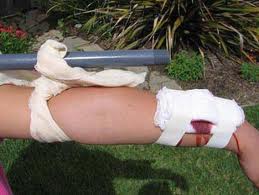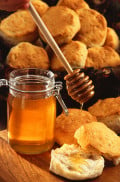Basic First Aid Tips Everyone Should Know
Day 8, HUB # 8

Update Yourself
Childhood injuries are unavoidable but we could take precaution measures to prevent injuries from happening.
When your child had a fall and scraped his knee, how do you treat it at home? Have you update yourself the new First Aid methods? Since old folks First Aid advice are not useful and outdated, we should learn to accept new knowledge from people with medical experiences such as nurses, doctors and paediatricians on how to treat our children most common injuries, so that they will heal quickly and keep them safe and sound.
Here are 4 common injuries that often happens at home and at work and these are the differences between the old and the new First Aid tips you should know.
1. Minor Cuts and Scrapes
Old method:
Wash the cut with tap water, soak cotton wool with hydrogen peroxide and dab over the cuts. Don’t bandage it, so that air can heal the wound faster.
New Method:
- Wash the scraped or small cuts with soap and warm water. Rinse off the soap with plenty of clear water.
- Make sure there is nothing stuck or embedded in the cuts. Sometimes, if a child had a nasty fall on the road, dirt and small particles of stones can become embedded in the wound. If these particles are left in, infection will develop and permanent scar on the skin will occur too.
- Hence, use a clean handkerchief or towel to scrub or brush off the small particles out of the wound, even if the child would scream in pain.
- Hydrogen peroxide destroys the white blood cells that help the wound to recover faster. Therefore, it can actually slow down the healing process.
- The best method is to use any anti-biotic ointment that you can get at the pharmacy stores. A minor abrasion or any break in the skin surface will allow viruses and bacteria to attack the wound. After you have applied antibiotic ointment on the cleaned wound, it is consider done and will start to heal on its own in a day or two.
- Bandaging is optional as the child would rather have the bandage on to ease his fear of pain. Put on the bandage if the wound is big that bleeds easily or the wound might accidentally rub against his clothes. Remember to change the bandage daily in order to discard the excess bleeding.
What do you do when your child has deep cuts?
Learn from the Professional
Dos' and Don't



2. Severe Bleeding or Deep Cuts
Old method:
Apply a tourniquet ( a device for stopping bleeding by twisting something tightly against the artery) to stop severe bleeding.
New method:
- Do not use a tourniquet because it will cease blood circulation not just to the severe bleeding area but to the whole limb. Furthermore, it can cause severe damage to all the tissues that don’t receive enough blood supply.
- The correct way to control severe bleeding or deep cuts is with direct pressure. If the injury is on the arm or leg, apply sterile gauze pads to the wound and press down firmly for at least 5-10min. Don’t remove the pads even if the gauze pads are soaked with blood.
- The reason is, it may interrupt the clotting process. Therefore, apply more gauze pads on top and continue to hold them in place. Then, wrap the gauze with bandage cloth to provide more pressure. Remember to make sure to raise the wound higher than the heart.
- Place an ice pack on top of the dressing because it will cause the vein to become tight or narrow. In this way, it will help to slow down the blood loss. If the severe bleeding does not cease after 5-10min, bring the child to the hospital for further dressing.
- For injury on the child’s body, call the ambulance at once and quickly cover the wound with gauze pads while waiting for the help assistants arrive.
- If you couldn’t find any sterile dressing or gauze pads at that critical time, cover the wound with a plastic bag, a piece of plastic wrap or latex glove. Remember to leave one corner loose.
- This is to keep the air away from the wound when the child breathes in and less air escapes when he exhales. A punctured wound caused by sharp object may cause sucking chest wound that will lead to breathing difficulty to the child.


3. Nose Bleeds
Old method:
Tilt the child’s head back, pinch his nostrils close and apply an ice pack to stop the bleeding.
New method:
- Tilt your child’s head upright or move it forward slightly. It is incorrect to tilt the head back because it allows the blood to flow down to the throat, which may result to choking or vomiting. Pinch the bridge of the nose, just below the nose bone for 15min.
- Apply a cold ice cube in the mouth, under the upper lip. However, most kids couldn’t stand the cold pressure. The truth is, with the cold ice cube, it will help to slow down the blood flow to the nose.
- If the child’s nose bleeds was caused by a hard hit object such as a ball, apply cold ice cube to the bridge of the nose to reduce the swelling.
- Alternatively, if your child couldn’t tolerate the cold pressure, spread out a thin towel and put the ice cubes in the middle. Wrap up the towel and apply to the upper lip or nose bridge

4. Burns
Old method:
Dab butter, toothpaste or petroleum jelly on to the burnt skin. Hold ice cube against the burn area and then apply antiseptic spray or cream.
New method:
- It is not wise to use butter or petroleum jelly because they keep heat inside the skin. Hence, the burns will worsen with inflammation. Ice cube and toothpaste will freeze the blood and damage the skin tissue.
- The correct way is to remove any clothing at the burnt area. You do not want any clothing stick to the skin, right? Next, quickly put the burnt area under cold running tap water for 5-10min. If the burnt was caused by a chemical, the water will wash it off soon. If the pain is still there, continue running under the cold tap water for another 20-30min.
- Do not apply any anti-septic spray or cream because they may create allergy to the child. Just apply an anti-biotic cream to the burnt area and cover it with dry bandage or handyplast.
- If the skin open blisters, take the child to the doctor immediately for further medication.
Do the Right Thing
Food that May Help To Comfort Your Child When He Is Hurt
- Chocolate Chip Raisin Muffins Recipe
Muffins are every child favorite especially when they are down with pain due to the injuries. Keep their mind away from touching the wound with these wonderful muffins - EASY QUICK BURGER RECIPE
Kids who love burgers would definitely not say "NO" to this. Just spoil them once a while. Let them feel better than crying the whole day. - LOW CHOLESTEROL DIET AND EASY RECIPES
Low cholesterol recipes are great for kids and adults. Why not cook these recipes for the family so that you don't have to cook different food for the injured child. - HOT TASTY PORRIDGE
Porridge is a great dish for patients, anyone who has lack of appetite and toddlers too. Best of all, porridge is low in cholesterol, healthy and suitable for those who are on a diet.
© 2012 peachy





